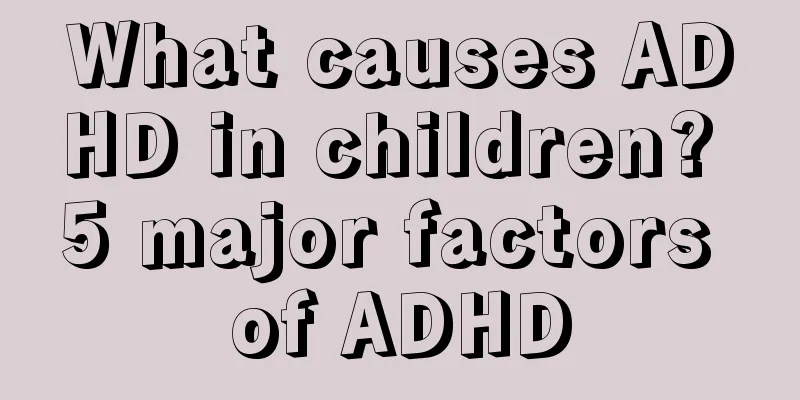What causes ADHD in children? 5 major factors of ADHD

|
Many parents feel that their children are always moving around, so they begin to wonder if their children have ADHD. So, what are the causes of ADHD in children? What are the causes of ADHD in children?1. Genetic factors: Family and twin studies have shown that genetic factors are an important cause of ADHD. Molecular genetic studies have shown that ADHD is a polygenic genetic disease that is closely related to neurodevelopment. 2. Organic brain factors: Studies have found that maternal infection during pregnancy, exposure to toxic substances, malnutrition, smoking, drinking, intrauterine distress due to various reasons, abnormal delivery, low birth weight, and central nervous system infection or brain trauma within 1-2 years after birth may all lead to abnormal neurodevelopment in children and increase the risk of ADHD. 3. Abnormal central nervous system neurotransmitters: Neurochemical studies have found that children with ADHD have insufficient norepinephrine function, insufficient dopamine function, and excessive or relatively insufficient serotonin function in their brains. These neurotransmitters are believed to activate the cerebral cortex or strengthen social behavior. Therefore, it is speculated that the cause of ADHD may be a behavioral disorder caused by neurotransmitter imbalance. 4. Social and psychological factors: Poor family and social environments may increase the risk of children suffering from ADHD. Children living in a disharmonious family environment are often in a state of tension, depression, fear, anxiety and contradiction, and are prone to behavioral problems such as impulsiveness, inattention, and emotional instability, or aggravate certain symptoms of ADHD. Improper education is also one of the risk factors for ADHD. Simple and rough education methods, excessive indulgence or overprotection may all become triggers of ADHD. 5. Other factors: Studies have found that if children consume too much lead-containing food, high blood lead levels may be related to hyperactivity and inattention, and may be a potential cause of ADHD. Symptoms of ADHD in childrenChildren with ADHD are generally called attention deficit hyperactivity disorder in medicine. ADHD is one of the most common psychological disorders in children and adolescents. Children with this disease have normal or almost normal intelligence but have defects in learning, behavior and emotions, which are manifested as difficulty in concentrating, short attention span, excessive activity, and impulsive emotions that affect their academic performance. They have difficulty getting along with others at home and school, and make it difficult for parents and teachers in daily life. Symptom 1: Lack of concentration 1. Often fail to pay attention to details or frequently make careless mistakes in homework, work or other activities; 2. Difficulty maintaining concentration at work or at play; 3. He often seems to be listening but not really listening when others are talking to him; 4. Often fails to complete homework, housework or work according to other people's instructions (not due to defiance or failure to understand); 5. Often have difficulty organizing work and study; 6. Often avoid, hate or are unwilling to do tasks that require concentration (such as schoolwork or homework); 7. Frequently lose items needed for study and activities (such as toys, school-assigned homework, pencils, books, or tools); 8. Often easily distracted by external stimuli; 9. It is easy to forget things in daily life. Symptom 2: Hyperactive or impulsive behavior 1. Frequently moving hands and feet or twisting in seats; 2. Frequently leaving seats in classrooms or other environments where sitting is required; 3. Frequent running or crawling around in inappropriate situations (for adults or adolescents, this is limited to subjective feelings of restlessness): 4. Often have difficulty playing quietly or engaging in leisure activities; 5. Often busy or constantly moving as if "on a motor"; 6. Often talk too much; 7. Often rushes to answer before others finish speaking; 8. Often have difficulty waiting quietly or queuing in order; 9. Often interrupt or interfere with other people's activities (such as interrupting or interfering with other people's games). Differentiating between ADHD and hyperactivity in children1. Children with ADHD have few hobbies and interests. Even if they use their favorite game consoles or children's TV programs, they cannot concentrate on them. However, naughty children are completely different. Not only can they concentrate on the activities they are interested in, but they also hate the interference and influence of others. 2. Children with ADHD are impulsive, disorganized, and have a beginning but no end. For example, they cannot concentrate on their homework, do it halfway, and are careless and sloppy. They start but never finish, often give up halfway or change frequently. The behavior of naughty children has a certain purpose and is planned and arranged. 3. Children with ADHD have poor self-control. No matter what the occasion, they are always busy and noisy. For example, they cannot sit still in the classroom, often twist in their seats, or stand up. In serious cases, they leave their seats and walk around, or leave the classroom without permission. They talk a lot, make noise, interrupt, and cause trouble, affecting classroom discipline to attract others' attention; naughty children are not like this. They can abide by their own rules in unfamiliar environments and serious occasions, dare not make trouble, and have strong self-control. Therefore, don't think that children have ADHD when you see them being hyperactive, and put the "hat" of multiple diseases on naughty children, which will bring them unnecessary psychological pressure. If you can't tell the difference yourself, you can go to a specialist hospital for a doctor to identify. Diet therapy for ADHDBlack Bean Pearl Claypot Turtle Ingredients: 50g mother of pearl, 50g black beans, and a turtle. practice: 1. Fry the black beans in a pan and crush the mother-of-pearl and place it in gauze. 2. Kill and clean the turtle, remove the internal organs, then cut into pieces and blanch with hot water. 3. Take a pot, add water and boil the above 3 ingredients. Pig Heart Stewed with Ganmai, Jujube, and Walnut Ingredients: 10g seedless red dates, 30g walnut meat, 60g floating wheat, 3g licorice, and a pig heart. practice: 1. Wash the pig heart, cut it open and remove the blood clot. 2. Add all ingredients into the pot and cook. |
<<: What should I do if my child has ADHD? ADHD coping methods
>>: Is it good to eat ginseng during pregnancy? How to eat ginseng during pregnancy
Recommend
What to do if you feel nauseous during pregnancy? What to eat? What to do if you feel nauseous during early pregnancy?
Women experience many symptoms during pregnancy. ...
Is Feihe milk powder goat milk powder or cow milk powder? Is Feihe milk powder hydrolyzed milk powder?
Feihe milk powder is a very common milk powder br...
How to determine your fertility
Pregnancy is the most sacred and great mission gi...
What are the symptoms of zinc deficiency in children and what causes it
Many children suffer from zinc deficiency because...
At what age does a baby stop wetting the bed? At what age does a baby stop wetting the bed?
Bedwetting is a necessary process for every baby....
Which is more scientific, diapers or wet diapers? The difference between diapers and wet diapers
Diapers and wet diapers are both care products th...
Is the baby shaping pillow useful and when should it be used?
Many mothers are afraid that their newborn babies...
Kindergarten breakfast recipes Kindergarten breakfast recipes
The school season is coming soon, and many babies...
What is baby rice cereal made of? Which brand of baby rice cereal has the best reputation?
We all know that babies drink breast milk and for...
Can babies drink high calcium milk powder? At what age is high calcium milk powder suitable for drinking
High calcium milk powder generally refers to high...
What to do if male sperm motility is low
Good sperm contributes to the birth of a baby. Fa...
Do children need to get the flu vaccine after they have had the flu? The reason why they can still get the flu after being vaccinated
Autumn and winter are the peak seasons for influe...
What should children do when they have nosebleeds? Two effective ways to stop bleeding
Nosebleed is a very common thing in daily life. S...
Will a baby's constant crying affect his health? Will a baby's constant crying be harmful to his health?
Does a baby's constant crying affect his heal...
What are the common misunderstandings about weaning? Don't empty your breasts
Breast milk is naturally the most nutritious food...









